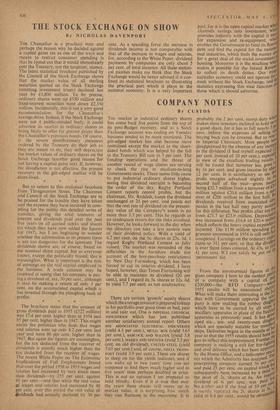COMPANY NOTES
By CUSTOS THE market in industrial ordinary shares has come back five points from the top of its post-Budget recovery, and as a Stock Exchange account was ending on Tuesday business tended to be more restricted. The gilt-edged market has also become more restrained except the market in the short- dated bonds which was helped by the fall in the Treasury Bill rate to 5 per cent. The funding\ operations and the threat of another round of wage claims are serving to check the rise in medium-to-long Government stocks. There seems little cause to put industrial ordinary shares higher, seeing that dividend restraint is becoming the order of the day. Rugby Portland Cement reports record profits, but the chairman, Mr. Reddish, keeps the dividend unchanged at 20 per cent. and. points out that the real rate of dividend on the present- day value of thp Company's assets is no more than 3.3 per cent. This he regards as an inadequate return for the risks involved. However, he looks forward to the day when the directors can take a less austere view of their dividend policy. With a yield of 4.2 per cent, on the 5s. shares at 23s. 3d. I regard Rugby Portland Cement as fully valued. The market was reminded of the difficulties in the furniture trade (on account of the hire-purchase restrictions) by New Day Furnishing, which has been forced to cut its interim dividend. I have hoped, however, that Times Furnishing will be able, to maintain its dividend (20 per cent.), and I regard its 5s. shares at 12s. 6d. to yield 7.7 per cent. as not unattractive.
There are certain 'growth' equity shares which the average investor is prepared to keep in his portfolio over good times or bad, year in and year out. One is IMPERIAL CHEMICAL INDUSTRIES which has just published another satisfactory annual report. Others are ASSOCIATED ELECTRICAL INDUSTRIES (yield 4.3 per cent.), METAL BOX (yield 3.65 per cent.), BABCOCK AND WILCOX (yield 3.8 per cent.), MARKS AND SPENCER (yield 3.3 per cent. on old dividend), UNITED STEEL (yield 5.65 per cent.) and, of course, SHELL TRANS- PORT (yield 3.9 per cent.). These are shares to sleep on (as the yields indicate), and if you wake up in two years' time you are supposed to find them much higher and in five years' time perhaps doubled in price. This is not an opinion I am prepared to hold blindly. Even if it is true that over the years these shares will move up in market value, it is surprising how much they can fluctuate in the meantime. It is probably the 2 per cent. stamp duty makes most investors inclined to hold a good share, for it has to fall nearly cent. before the expenses of sellink buying back can he covered. But to to Imperial Chemicals. Most people disappointed by the absence of any in1 in the dividend (I had myself expecte per cent. instead of 10 per cent.), espe in view of the excellent trading rest will be found that turnover has got by 16 per cent. and gross income by 12 per cent. It is satisfactory to sec profit margins advanced slightly it second • half of the year-gross in being £32.7 million from a turnover of million against £20.8 million from a over of £206 million in the first hall dividends received from associated panics in the last half may partly acs for this difference. Net profits after tak from £21.7 to £23.9 million. Depreci was increased from £16.6 to £20.4 which reflects the heavy capital expent incurred. The £130 million spending gramme announced in 1954 is still on': completed. Earnings on the ordinary e came-to 311 per cent. so that the div is over three times covered. At 45s. to 4.1 per cent. 1CI can safely he pia 0 'permanent' list.
From the astronomical figures of giant company I turn to the modest
yrofT), of a company with a capital of °ost £200,000-the RFD CompanY-c 1955 results will be announced sh What will make them interesting is the facl that with Government approval the c0rr,. patty is now making the rubber di9gbiei which have to be carried by all silt ancillary apparatus in place of the bU0 yeh apparatus as previously used. It has, de A oped six-,. ten- and twenty-men dingbfr which are specially suitable for mell 11h "I ships. Deliveries began in the middle 0 year so that the 1955 results should ha'c,thsct gun to reflect this improvement. Furthe. 614 company is making a raft for fire-118. J and civil defence which has been arr by the Home Office, and a helicopter 11 sclif net which the Admiralty has accePte-' enterprising company earned 56 Pc! has and paid 25 per cent. on capital subsequently been increased by a third the issue of 2s. shares at 65. An 1,111erifil 1351 dividend of 6 per cent. was pattl
No ,.e:nbc.r and if the final of 10 Per j
°II'
is merely repeate.d the 2s. shares at, , yield of 6.4 per cent., would be ohm°
which on IC 5 l'el, 301 refjlrt well Ogg d
Its. I
grit
coo on
atilo en 116 1 1h
c
thn� Ihr aft £2('' torn' Ilion hurt
pro: P










































 Previous page
Previous page